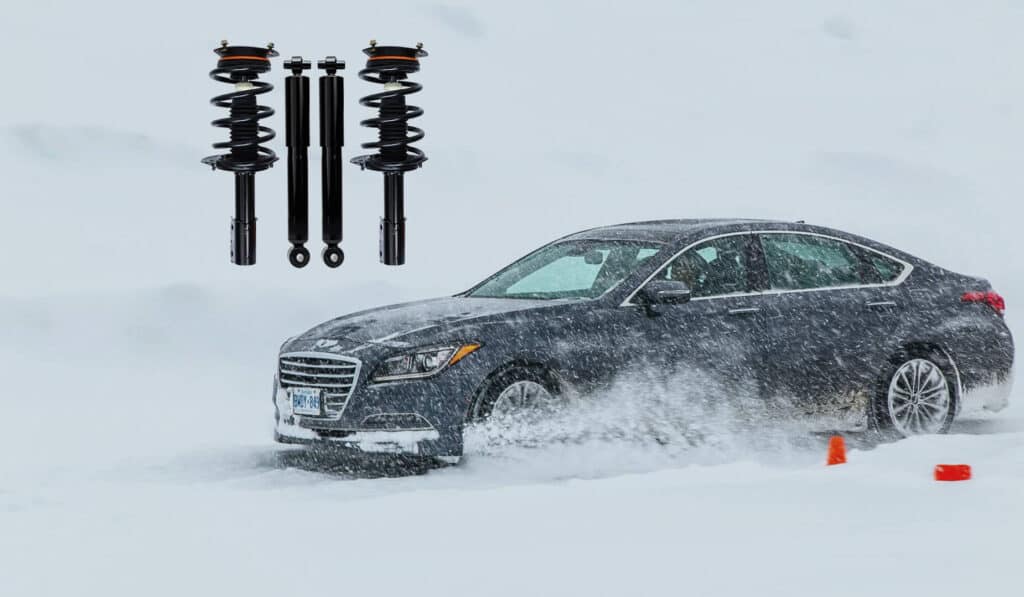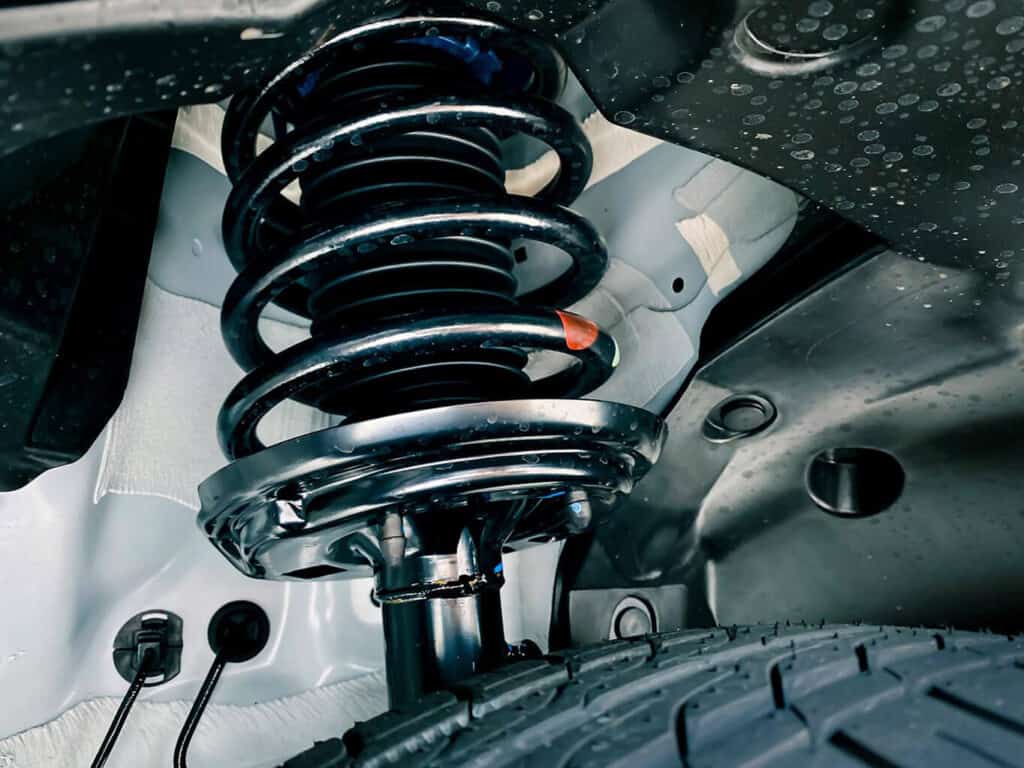A Canadian Odyssey — When Your Car Takes on the Elements
Picture this: it’s a bone-chilling winter morning in Canada, and you’re in your garage having a hot cup of coffee, chatting about the weather’s toll on your vehicle. As you step into your car and drive through the snow-covered roads, you feel a slight difference in your ride’s quality. Ever wonder why? Well, welcome to the reality of Canadian weather and its impact on your car’s suspension system, especially the shock absorbers and struts.
The Ice Age Challenge: How Cold Weather Affects Shock Absorber Performance
The Fluid Freeze-Up: At the core of your shock absorbers is hydraulic fluid, which essentially acts as the bloodline, making sure your ride is smooth. Just like olive oil thickens in the fridge, the hydraulic fluid in your shocks thickens in cold weather. This viscosity change can lead to less effective damping. As a result, your car might feel like it’s riding on a wooden cart rather than a cushion of air.
Safety Impact: Now, a stiffer ride might not sound like a big deal, but it’s a different story when it comes to safety. In a situation requiring sudden braking or quick maneuvering, a stiffer suspension can reduce your car’s ability to absorb shock effectively. This could translate to longer stopping distances and less stable handling—two things you don’t want, especially on icy Canadian roads.

Comfort Compromise: Besides safety, there’s the comfort factor. A vehicle that’s bouncing around more than usual can make for a jarring journey. For those who frequently travel long distances in winter, the added physical stress can turn what should be a simple drive into an unpleasant experience. Imagine driving over a gravel road for hours; it’s hardly the stuff of serene winter wonderlands.
The Importance of Winter Checks: Given these challenges, it’s critical to perform regular checks on your shocks during the winter months. Whether you’re a DIY enthusiast or prefer to leave it to the professionals, make sure your shocks are in tip-top shape before the season begins.
Cold-Resistant Solutions: For those who want to go the extra mile, some manufacturers offer shock absorbers designed specifically for colder climates. These specialized products use a different type of hydraulic fluid and materials that are less susceptible to the effects of low temperatures, providing a more consistent performance regardless of how cold it gets.
The Pothole Predicament: Thaw, Freeze, and Your Struts
Ah, the infamous Canadian potholes. A nuisance for drivers and a peril for car struts. Potholes are essentially the craters on the moon of Canadian roads, created and exacerbated by the relentless freeze-thaw cycles. As temperatures fluctuate between freezing and thawing, water seeps into the cracks in the road, expanding as it freezes and contracting as it thaws. This process loosens the asphalt, making it more susceptible to disintegration under the weight of passing vehicles. For your struts, each encounter with a pothole is like taking a punch in a boxing match — jarring, impactful, and potentially damaging.
So, what happens to your struts? Every time your vehicle dips into a pothole, it places enormous stress on your struts, compressing them to absorb the shock. Over time, this kind of pressure can lead to premature wear and even structural damage, especially if the struts are already old or compromised. This is why it’s particularly important to be cautious during the transitional seasons of spring and fall. Potholes are most prevalent during these periods, and your struts are at greater risk of damage. In short, navigating a road full of potholes without proper strut integrity is like sailing a leaky boat through rocky waters.
Salted Roads, Rusted Shocks: The Corrosive Conundrum
When winter comes, so does road salt, the double-edged sword of winter driving. While its application is crucial for melting ice and providing some semblance of grip on slippery roads, it’s the automotive equivalent of kryptonite for your shocks and struts. Salt is highly corrosive and, when it makes contact with the metal components of your shocks, it can accelerate the rusting process, potentially reducing their operational lifespan by years.
It’s not all doom and gloom, though. Preventive measures can be taken to mitigate the corrosive impact of road salt. One effective strategy is to wash your car frequently during the winter months, focusing particularly on the undercarriage. This helps to remove the salt before it has a chance to do significant damage. It’s also advisable to apply a corrosion-resistant coating to the metal components if possible, which acts as an added layer of protection. So, while road salt is necessary for safer winter driving, it’s crucial to understand the price your vehicle’s underbelly might pay, and take steps to mitigate the risks.
The Heat Wave Hassle: Don’t Overlook the Summer
Oh, the joys of a Canadian summer: barbecues, lake trips, and…shock absorber issues? Yes, you read that correctly. While we often focus on the challenges posed by Canadian winters, we mustn’t ignore the heat wave hassles of summer. High temperatures can affect your vehicle’s shock absorbers in ways you might not expect. For instance, the hydraulic fluid inside the shocks can thin out as temperatures rise, reducing their ability to cushion your ride effectively.
But wait, there’s more. Summer often coincides with increased driving. Whether you’re heading out on a long road trip or simply enjoying more frequent drives to the beach, the extra miles add up. More driving equates to more work for your shocks and struts, which when coupled with reduced hydraulic efficiency, can lead to faster wear and tear. In short, while your mind may be on sunsets and sand, keep an eye on your suspension system to ensure it’s up to the rigors of summer driving.
DIY Tips for Climate-Proofing Your Suspension
• Seasonal Inspection: Before winter or summer kicks in, conduct a thorough inspection of your shocks and struts. Look for signs of wear, leakage, or corrosion. Use a flashlight to check the inner parts for hidden issues.
• Clean the Components: After inspection, make sure to clean off any dirt, road salt, or debris using a brush and a mild detergent. This prevents accumulated grime from causing premature wear.
• Lubrication: Apply a suitable lubricant to moving parts such as bushings and joints. Use grease that is rated for high-performance or all-weather use to ensure longevity.
• Check Hydraulic Fluid: The fluid in your shocks and struts can become less effective due to extreme temperatures. If possible, check the fluid consistency and replace it with a more temperature-resistant variety if necessary.
• Installing Protective Boots: If you’re comfortable with some basic mechanics, consider installing protective boots or covers over your shocks and struts. This keeps out debris and can reduce the impact of road salt.
• Tighten Up: Make sure that all bolts and fastenings are tightly secured. Loose components can exacerbate wear and tear during rough seasonal driving.
• Test Drive: After performing these maintenance steps, take a short test drive to make sure everything feels right. Listen for any unusual noises and pay attention to how the car handles bumps and turns.
• Consult Your Mechanic: If you’re unsure about any of these steps, or if your inspections reveal possible issues, don’t hesitate to consult a professional for advice.

Specialized Products: The Value of Winter-Ready Shocks and Struts
• Material Matters: When shopping for winter-ready shocks and struts, look for products made from corrosion-resistant materials like stainless steel or aluminum.
• Cold-Resistant Hydraulic Fluid: Some high-end models come with specially formulated hydraulic fluid that performs consistently in extreme cold, giving you a smoother ride even when the temperature plummets.
• Enhanced Seals: Look for shocks and struts with enhanced sealing technology. These seals are designed to keep out water, road salt, and other corrosive materials.
• Adjustable Settings: Some specialized shocks and struts offer adjustable settings that allow you to tweak performance based on current weather conditions. This feature can be particularly useful during the transitional seasons of spring and fall.
• User Reviews and Ratings: Always check customer reviews and ratings when considering a particular brand or model. Real-world testimonials can provide invaluable insights into how the product performs in Canadian conditions.
• Warranty and Support: Since you’re investing in specialized equipment, make sure to check the warranty conditions. A product with robust customer support and a lengthy warranty period will give you peace of mind.
• Cost-Effectiveness: Though these specialized products may come with a higher upfront cost, they often prove more cost-effective in the long run due to their durability and lower maintenance needs.
Preparing for All Seasons — Your Takeaway Survival Guide
Canadian weather can be as unpredictable as a moose crossing the road, but that doesn’t mean your drive has to be. By understanding the unique climate challenges and taking proactive steps, you can keep your vehicle’s suspension system in top form all year round. And for those looking for expert guidance, consider Uchanics for your car’s suspension needs. Stay comfortable, stay safe, and most importantly, keep cruising through Canada’s diverse seasons.
